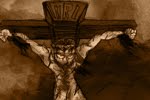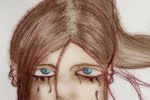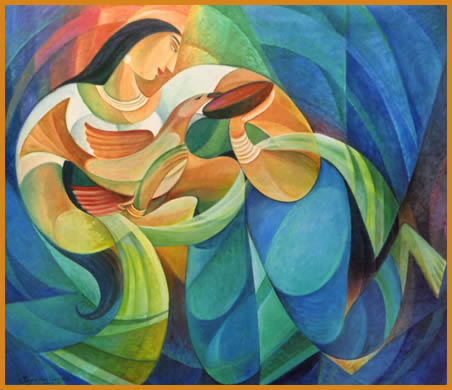Sunday, June 6, 2010
A.C.G.S.AMARASEKARA (1883-1983) PORTRAIT -1966 OIL ON CANVAS 71 X 56 CM
HISTORY OF PAINTING & SCULPTURE IN SRI LANKA Jagath Weerasinghe
1.0 INTRODUCTION
Sri Lanka is an island civilization with a long, rich and colourful history. Its pivotal position in the ancient Silk Road, that functioned as a cultural highway between the East and West, has given this island a cosmopolitan character since pre-Christian times. In the inscriptions of a Mauryan Emperor of India in the 3rd century BC, Sri Lanka was referred to as Tambapani. He names it as one of the countries to which he had extended his benevolent services. Onesicritus of Astipalacia who was among the convoy of Alexander the Great in his eastern campaigns (326 to 323BC) referred to Sri Lanka as Taprobana.
The writings and cartography of the Greek geographer Ptolemy or Claudes Ptolomeus of Alexandria of 2nd century AD presents us with an account of Sri Lanka, its topography, economy and culture, showing the extent of contacts that existed between Sri Lanka and the west in the ancient times.
The ancient Indians called Sri Lanka the Sieladiba (Pali Sihaladipa).
An epigraphic record of this name has been found in an inscription of Asoka, in the Tinnevely district of Tamilnadu in South India.
In an inscription of the 4th century Gupta Emperor Samudragupta, Sri Lanka is referred to as Sainhalaka, the Land of the Sinhalas.
Sri Lankan links with the rest of the Asia has been as extensive as with the West and the Indian subcontinent. Chinese sources refer to many occasions of cultural, political and trade exchanges between the two countries. The maritime expeditions of Cheng Ho are a clear indication of the sustained links between Sri Lanka and China. However, the links with China waned with the expansion of European power in the Indian Ocean.
The history of Sri Lankan painting and sculpture can be traced as far back as to the 2nd or 3rd century BC. The ancient historical chronicles of Sri Lanka; such as the Mahavamsa, written in the 6th century AD has numerous references to the art of painting and sculpture in Sri Lanka. The earliest reference in the art of painting is to the drawing of a palace on cloth using cinnabar in the 2nd century BC. The ancient chronicles have description of various examples of paintings in the relic-chambers of Buddhist stupas, and in monastic residence. Fragmentary remains of early wall paintings have been recorded from various archaeological sites. The Mahavamsa also refers to numerous description of sculptures and carvings in ancient buildings such as at the Loha Pasada, a monastic residence in the ancient city of Anuradhapura.
In many ways Sri Lankan art is an expression of its long and enduring Buddhist tradition that has absorbed and internalised numerous regional and local traditions for thousands of years. The Indian mark in the Sri Lankan art is obvious and deep, it has not inhibited the formation of a distinctly Sri Lankan tradition in the arts. The persistence and the strength of this distinctly Sri Lankan character can be noticed in Buddha images of Anuradhapura and in the bronze sculptures of Hindu Gods and Goddesses made in the Kingdom of Polonnaruwa dating from the 11th to 13th centuries.
Many art historians treat Sri Lankan art in relation to successive 'Kingdoms' that ruled the island from about 2nd century BC to the 19th century AD. While this type of periodisation has been extremely useful in reconstructing the history of art, the 'Kingdom' and 'King' centered approach to history of art does not pay sufficient respect to the broad stylistic continuities and changes that the practice of painting and sculpture in Sri Lanka show in its long history. Traditional historiography presents Sri Lankan art in terms of Anuradhapura, Polonnaruwa, Dambadeniya, Yapahuwa, Kotte, Gampola and Kandy, the successive kingdoms of pre-modern Sri Lanka. In this essay, however, following Senake Badaranayake (1986), the history of painting and sculpture is presented considering the broad stylistic similarities and changes of the Sri Lankan painting tradition. The historical phases of the island are divided into five periods as:
1. Early Historical period: 250BC - 500AD
2. Middle Historical period: 500AD - 1250AD
3. Late Historical Period - 1: 1250AD - 1600AD
4. Late Historical Period - 2: 1600AD - 1800AD
5. Modern Historical Period: 1800AD - 1900AD (Bandaranayake 1986).
These periods are treated in relation to the broad stylistic changes that can be delineated from the history of art practice in pre-modern Sri Lanka.(http://www.artsrilanka.org/)
Read more
Sri Lanka is an island civilization with a long, rich and colourful history. Its pivotal position in the ancient Silk Road, that functioned as a cultural highway between the East and West, has given this island a cosmopolitan character since pre-Christian times. In the inscriptions of a Mauryan Emperor of India in the 3rd century BC, Sri Lanka was referred to as Tambapani. He names it as one of the countries to which he had extended his benevolent services. Onesicritus of Astipalacia who was among the convoy of Alexander the Great in his eastern campaigns (326 to 323BC) referred to Sri Lanka as Taprobana.
The writings and cartography of the Greek geographer Ptolemy or Claudes Ptolomeus of Alexandria of 2nd century AD presents us with an account of Sri Lanka, its topography, economy and culture, showing the extent of contacts that existed between Sri Lanka and the west in the ancient times.
The ancient Indians called Sri Lanka the Sieladiba (Pali Sihaladipa).
An epigraphic record of this name has been found in an inscription of Asoka, in the Tinnevely district of Tamilnadu in South India.
In an inscription of the 4th century Gupta Emperor Samudragupta, Sri Lanka is referred to as Sainhalaka, the Land of the Sinhalas.
Sri Lankan links with the rest of the Asia has been as extensive as with the West and the Indian subcontinent. Chinese sources refer to many occasions of cultural, political and trade exchanges between the two countries. The maritime expeditions of Cheng Ho are a clear indication of the sustained links between Sri Lanka and China. However, the links with China waned with the expansion of European power in the Indian Ocean.
The history of Sri Lankan painting and sculpture can be traced as far back as to the 2nd or 3rd century BC. The ancient historical chronicles of Sri Lanka; such as the Mahavamsa, written in the 6th century AD has numerous references to the art of painting and sculpture in Sri Lanka. The earliest reference in the art of painting is to the drawing of a palace on cloth using cinnabar in the 2nd century BC. The ancient chronicles have description of various examples of paintings in the relic-chambers of Buddhist stupas, and in monastic residence. Fragmentary remains of early wall paintings have been recorded from various archaeological sites. The Mahavamsa also refers to numerous description of sculptures and carvings in ancient buildings such as at the Loha Pasada, a monastic residence in the ancient city of Anuradhapura.
In many ways Sri Lankan art is an expression of its long and enduring Buddhist tradition that has absorbed and internalised numerous regional and local traditions for thousands of years. The Indian mark in the Sri Lankan art is obvious and deep, it has not inhibited the formation of a distinctly Sri Lankan tradition in the arts. The persistence and the strength of this distinctly Sri Lankan character can be noticed in Buddha images of Anuradhapura and in the bronze sculptures of Hindu Gods and Goddesses made in the Kingdom of Polonnaruwa dating from the 11th to 13th centuries.
Many art historians treat Sri Lankan art in relation to successive 'Kingdoms' that ruled the island from about 2nd century BC to the 19th century AD. While this type of periodisation has been extremely useful in reconstructing the history of art, the 'Kingdom' and 'King' centered approach to history of art does not pay sufficient respect to the broad stylistic continuities and changes that the practice of painting and sculpture in Sri Lanka show in its long history. Traditional historiography presents Sri Lankan art in terms of Anuradhapura, Polonnaruwa, Dambadeniya, Yapahuwa, Kotte, Gampola and Kandy, the successive kingdoms of pre-modern Sri Lanka. In this essay, however, following Senake Badaranayake (1986), the history of painting and sculpture is presented considering the broad stylistic similarities and changes of the Sri Lankan painting tradition. The historical phases of the island are divided into five periods as:
1. Early Historical period: 250BC - 500AD
2. Middle Historical period: 500AD - 1250AD
3. Late Historical Period - 1: 1250AD - 1600AD
4. Late Historical Period - 2: 1600AD - 1800AD
5. Modern Historical Period: 1800AD - 1900AD (Bandaranayake 1986).
These periods are treated in relation to the broad stylistic changes that can be delineated from the history of art practice in pre-modern Sri Lanka.(http://www.artsrilanka.org/)
Subscribe to:
Posts (Atom)























